Release forms: Although only 4 out of 6 of my interviewees filled in the release forms, they have all given me permission to put my film with them in it online and on my page.
Release forms: Although only 4 out of 6 of my interviewees filled in the release forms, they have all given me permission to put my film with them in it online and on my page.
At the beginning of the week I spent some time reflecting upon the work I did last week and then conducted some research about interviews and how they vary in documentaries, I watched some documentaries to help me look at a range of interviews in more detail and learn more about how to create effective interviews in my own film. I also spent some time looking for people who I may want to contact in and out of college, to be in my interviews.
I spent a lot of my time on Tuesday researching anti-bullying schemes, policies, charities etc in Sheffield, I did this in hopes that I would find some people who might be able to be interviewed. I got into contact with a Students Union worker from college who works within the pastoral team, I emailed a support group; Camerados, I also emailed the ‘children’s involvement’ team who are part of the government/Sheffield council and I emailed Sheffield Springs Academy about their students work with their anti bullying scheme. Doing this helped made me more organised and determined to find contributors for my film and it made me more confident with talking to people.
Below are the emails I sent:
From these emails I received only one reply; Amy Smith said she would be happy to be interviewed as part of my film. I was really relieved when I received this email and was happy to have a contributor that was willing to talk about bullying for my film. Once I received this email I decided to make sure that all of the information was given to Amy asap so that she knows what is happening with my production. Below are the emails that were sent/received from Amy. Once I knew I had Amy and some of the Camerados team that were willing to be interviewed in my film, I was feeling more confident about my film, I then decided to do a bit more research about other people I could contact incase I didn’t get any more replies from the emails I sent.
Towards the end of the week I emailed the Firth Park team that had previously been emailing me about my film, I decided to do this to make sure that it was clear of what I wanted to shoot at their school. Even though they had denied me access to use their students and location to shoot interviews I had asked permission to shoot cutaways in the classrooms and hadn’t heard anything back since.
 Doing this did make me feel like I was pestering the school however I did feel better about clearing up exactly what it was that I wanted to film (after I was denied interviews.) I have learnt from my experiences with Firth Park bailing on my film, that I should always make sure that I have a back up plan for my film incase this happens again. I realised that I needed to organise more contributors and didn’t leave myself a lot of time to do this, and so this has made me learn to plan more in advance and try to contact contributors more in advance too.
Doing this did make me feel like I was pestering the school however I did feel better about clearing up exactly what it was that I wanted to film (after I was denied interviews.) I have learnt from my experiences with Firth Park bailing on my film, that I should always make sure that I have a back up plan for my film incase this happens again. I realised that I needed to organise more contributors and didn’t leave myself a lot of time to do this, and so this has made me learn to plan more in advance and try to contact contributors more in advance too.
This week has been a challenge for me as I have had to conduct a lot of research and planning including contacting people regarding my contributors, I believe this has been hard because its meant me having to wait on other people. I have learnt that in future projects, not only as a filmmaker but as a person that I shouldn’t just rely on one thing at a time and I should always have a back up just in case something changes or goes wrong. Even though I feel like I haven’t made a lot of progress regarding my film this week, I feel like I have developed as a filmmaker and overall as a person.
Next week I will try to find more contributors for my film and keep in contact with the people have I spoke to this week.
This week I have conducted further research including starting my textual analysis, I wanted to do a textual analyse to be able to analyse in detail what is expected of a documentary and how I will be able to incorporate the typical codes and conventions into my own film. I planned out my questions for my interviews and contacted my contributor (Firth Park) giving them more details about my production, I did this to make sure that everything was organised ready for shooting as soon as they said I could.
After meeting up with the teachers from Firth Park last week, I spent some of my time starting my pre-production whilst keeping in contact with my contributors. I received an email at the end of last week (at the weekend) asking for which dates I want to start filming and whether I want to start filming straight away after the Easter holidays. 
After talking about this with the teachers from Firth Park and getting permission to film straight after the Easter holidays, I decided to get ahead with the pre-production and start planning what needed to be done for filming. I firstly started off by creating a scene breakdown, I decided to do this first to give me a better idea of what I wanted to accomplish from each scene in my film and exactly what I needed to shoot at each location.
I started off with my opening shot, before doing my scene breakdown I didn’t really have a good idea of what I wanted my film to start like so before I did this document I created a mind map to help me generate and develop ideas for this opening shot. Here is the mind map I created:
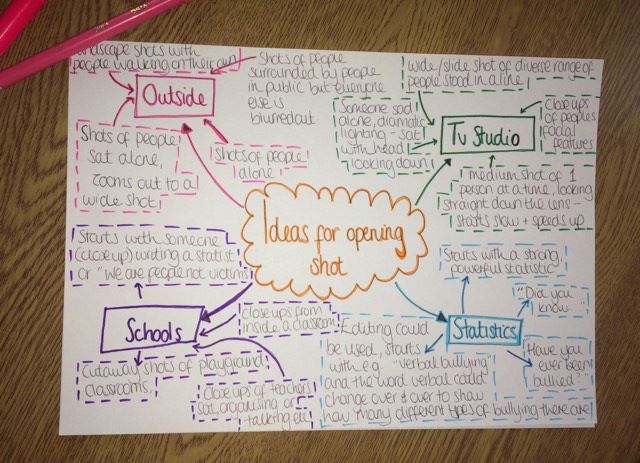
After doing this mind map I decided to ask my friends and family what they think my film should start with and whether they liked my ideas that I had come up with. I had a few comments made about the ideas I jotted down, one person said “I think that your idea to have shots of a range of people will look really good as it will show diversity” this idea was one of my favourite ideas to do and so getting other people’s opinion saying that it would work well and they think that it’s a good idea to open my film with made me more confident with this idea. Another said “I like the idea of the editing with the writing to show the different types of bullying however I think if you go straight in with statistics it might be a bit too full on, I think statistics should be added further into the film.” I agree with this comment, I think that I will add statistics further into the film instead of opening it with this. After getting some opinions on my ideas I have decided to open my film with my original idea to use the shot in the TV studio. Doing this mind map has helped me a lot with generating ideas, even though some people didn’t like the ideas I wrote down for my opening shot I got a lot of feedback about where those ideas could go instead of it being at the start of my film. Once I finally decided on the type of opening shot I wanted, I then did my scene breakdown documents for this scene (below.)
I then finished this document by doing a breakdown for all the scenes in my film: opening shot, interviews, cutaway’s and the closing shot. Similarly to the opening shot I did a mind map for the closing shot, this was for the same reasons as I wasn’t sure on my ideas and needed to generate more shot ideas and get feedback on them.

Again, I asked my family and friends for feedback on my ideas, my initial idea was to use a statistic, show charities that help with bullying and then cut to the credits and so I wanted to see what other people thought would be good to end my film on. I got a lot of comments on my ideas for the credit scenes, “Using the crayons and writing the credits out will look really good if done properly, there might be an editing tool that you could make this look better than doing it hand drawn” another said “Having the credits move when the school book pages turn will look really nice at the end of your film” although the credit scene isn’t what I was hoping to focus on, this feedback has given me confidence in the ideas I have come up with. I will decide on my credit scene after I have planned out all of my filming. I asked for more comments on my closing shots instead of the credits, one person said “Ending on a statistic will bring the film to a summary and will end the film well” I agree with this and think that using a statistic will create closure at the end of my film, overall this mind map has allowed me to develop my ideas, bring in other people’s creative ideas for shots and decide on what I want in my film and how to close it.
Below is all of my finished scene breakdowns:
After finishing my scene breakdowns I then moved onto doing the location recce’s: to be more prepared and get more info about the location we were going to be shooting in, risk assessments: to make sure that any risks are prevented when shooting and finally, shooting days planning: to make it clear when everything is being shot and what cast and crew will be needed on each day. (Below) Doing all of this pre-production has helped me be more organised and prepared for filming and I am feeling really excited to get started .
I firstly started off with my location recce’s, this gave me a chance to reflect on each location, and also gave me a chance to find out whether or not I have permission to film there and summarise how the filming will be effective if there are any sound issues in that location. After doing this I am now prepared for filming in both locations and I am aware of what precautions I will need to take when filming there.
The next part of pre-production I did was the risk assessments, after I finished my location recce’s I knew that I had permission to film in those locations however I needed to then evaluate the risks and safety at each place. Below is part of the risk assessments that I did (all complete pre-production is in a separate post). Evaluating the risks in each location, allowed me to plan out what solutions and precautions I will take when filming and how I will ensure all of the cast and crew are safe whilst on set.
After organising the risk assessments and location recce’s for each location, I then sorted out out a shooting day table (below) this helped me organise where me and the crew will need to be on each day and what is expected to be done in that shooting day. I am yet to sort out my crew however now that I know when I will be shooting I will be able to find out availability and organise who my crew will be on each day.
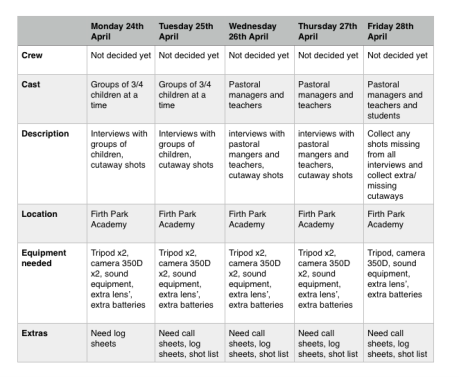
So far, all of the pre-production has given me a chance to become more prepared for filming, it has made me focused on what I am trying to achieve with my film and what my goals are.
In the middle of the week I received an email from Firth Park, asking for more in-depth detail about what I need to film. The email below is what I got sent.
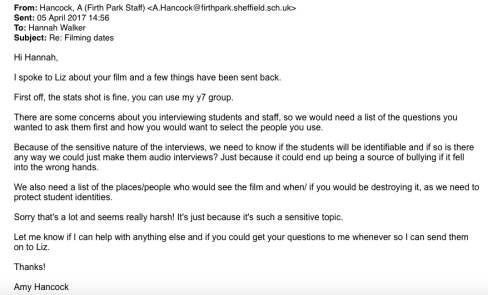
After receiving this I then needed to plan out exactly what I wanted in my film, the questions I will be asking in the interviews, whether or not the students will be identifiable and where the film will be distributed. And so I created a third-party list, list of questions that will be asked in the interviews and made sure that all the information that was asked for was given straight away.
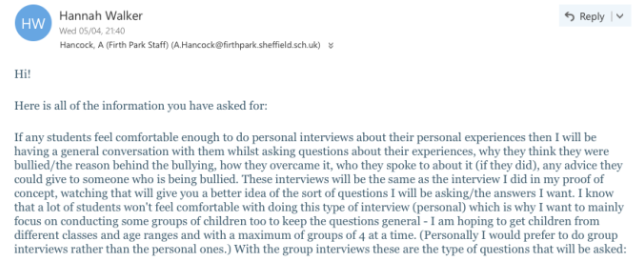
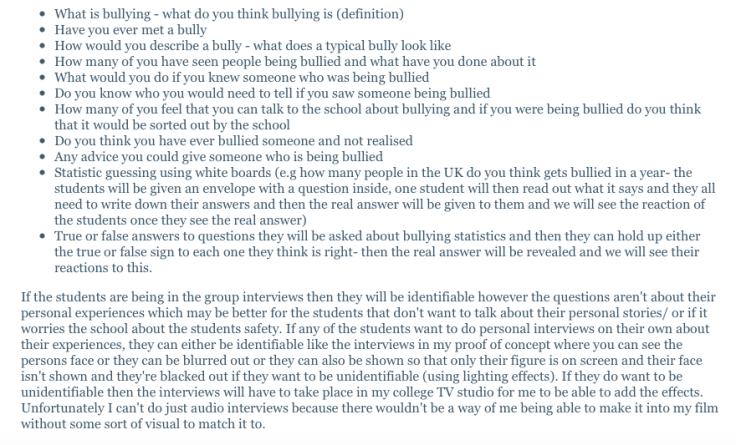
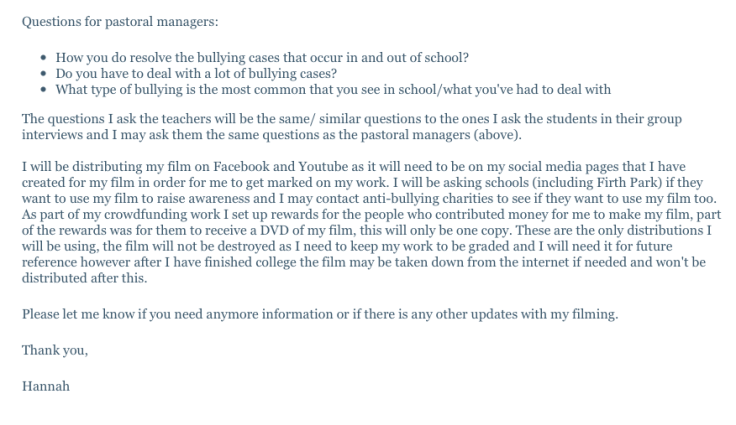
Once I had replied I decided that as everything was happening quite quickly I should carry on with my pre-production and research to make sure that I am prepared to film as soon as possible. I planned out all of the logistics that would need to be organised in order for me to get the crew and equipment to and from the location. Doing this made me more aware of what I need to do to make sure that everything runs smoothly on the day of filming.
At the end of the week after sending off all of my information about filming, Firth Park backed out of filming, their reasoning is in the emails I received (below).
Even though, the school turned down everything I had planned to film they only mentioned that they didn’t want their students to be put into danger by what they were saying as so I emailed and asked about whether or not I will be able to film cutaway shots in the school, without any interviews etc. I am yet to hear back about this. I am very disappointed that the school have rejected the film being made as I had a lot of my pre-production done and they had previously given me permission however I will try to keep in contact with the school and see if they can give me permission to do cutaway shots.
Overall this week has been full on with planning and pre-production and I have been let down by not being able to film there any more, however it has allowed me to develop my organisation skills and planning skills and it has made me realise that in this sort of industry there is going to be set backs, and I have learnt/am learning how to deal with that. Another key thing I have learnt this week is that keeping on top of planning and pre production is effective and really does a positive effect on the overall outcome of a film, I will make sure to stay on top of my preproduction even when set backs like this one occur.
Next week I will make sure that all pre-production is organised in case of any changes and I will make sure that I am prepared incase they give me permission to film cutaway’s. I will try to get into contact with the school to find out more information and I will continue with research and planning.
This week and next week I am off college and so I will focus on planning my film, research and pre-production, this will allow me to be prepared for when I am back at college after the break.
At the start of this week, I spent a lot of my time organising the pre-production I had previously organised for the shooting at Firth Park, I made sure that it was done properly and I was prepared for filming if any changes were made. I emailed the teachers at Firth Park who were helping with my film and asked them if there were anyway I could film only cutaway shots. Staying organised with the pre-production will allow me to start filming straight away if they change their minds about letting me film at their school.
To make sure I was fully prepared for any possible filming at Firth Park, I carried on with pre-production, this way I would be able to film straight away if they gave me permission to film cutaways rather than not having anything ready. I did my AV script, call sheets and shot list (shown below). I have included planning for the interviews and cutaways.
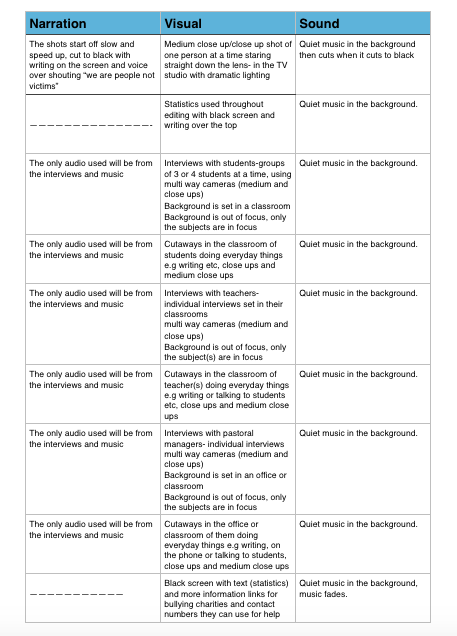
Creating my call sheets for the days I had planned to shoot on (at Firth Park) made me plan out exactly what my cast and crew will need to know if we get the chance to film there. I will give these out to all of my crew before we start filming so that they know all of the details about the shoot and what is expected from each day.
The last part of the pre-production was creating a shot list of all the shots I want in my film, I will take this on set with me when filming and I will make sure that the crew are aware of this sheet or have their own copies so that they know exactly what shots need filming on each shooting day.
Doing all of this pre-production has allowed me to not only be more prepared for filming but it has improved my organisation skills and it has given me the chance to develop my ideas, create new ideas and plan out exactly what I want to achieve from my film. Next week I will plan out more ideas for my film incase Firth Park turn down me doing cutaways, I will decide what I want to go into my film and add to/change pre-production.
This week I will focus on coming up with more ideas for my film (as I will now have to start from scratch), I will plan out what ideas I want to go into my film and start my pre-production if I can, at the end of the week. Last week I had conducted a lot of planning to film at Firth Park and got turned down to film there. As I am pushed for time I will try to come up with ideas that I know I will be able to film and hopefully they will be just as effective once my film is done.
I decided to create some minds maps to help me generate more ideas for my film, I firstly started off by doing one for the type of interviews I could use in my film. I came up with some ideas about what type of interviews I could use and which ones I have thought would look good to use in my film. From this mind map I was able to jot down any of my initial ideas and build upon them, once I had some good ideas wrote down I decided to ask a few of my family and friends for their opinions and whether they could give me any suggestions. One of which said “I think that it would be really interesting to talk to the ambassadors if you can, I think that it will give you a really good opportunity to talk to young people and show their opinions in your film” another said “doing a focus group style interview in your film would look good if you’re trying to show a lot of people’s different opinions on what bullying is” asking for these opinions helped me decide what ideas will look and work best in my film. Even though I am confident with the ideas I have come up with for interviews, I am going to conduct some more research into what type of interviews are the most common to use in documentaries, this will help me decide what interview types I will use. Below is my finished mind map.
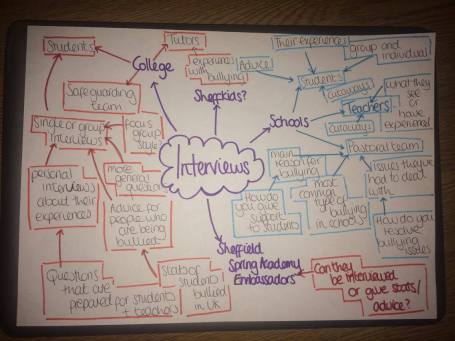
As my interviews mind map was successful I decided to do one to help me get more ideas for the types of cutaways I could use and how I could get statistics into my film in different ways. One of my initial ideas was to use a statistic shot in a classroom and ask the class a question then add in the statistic in (in the edit) after the class showed their reactions to a question I’d ask. Even though Firth Park pulled out of filming I still wrote this down to develop ideas from this one. I wrote down a lot of my ideas and again asked for people’s opinions on this, one person said “using school as a place to add in statistics is a good idea, I like the idea of using someone writing the statistics in a school book, I think that will look really good” I am hoping to add in statistics in a different way to just editing it in after I have filmed so having people agree with my ideas to do this has made me a lot more confident about doing this. This story board has allowed me to develop my ideas and ask people for their thoughts and opinions on them, I am a lot more confident on my ideas and have a better idea of what I am hoping to add into my film. Once I finished my mind map I did some further research about statistics and which statistics I want to go into my film. Below is my final mind map.
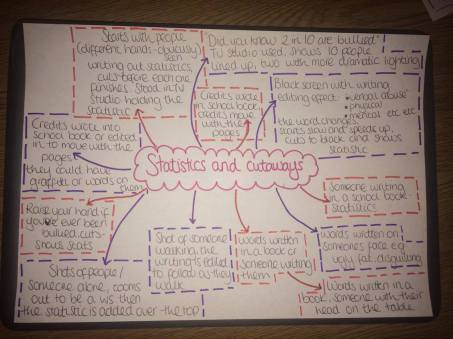
Generating ideas and doing more research has given me more knowledge on documentaries and what should go into them and it has allowed me to get people’s opinions on my ideas, which has made me more confident in my initial ideas and overall in my film.
As I spent a lot of my time creating mind maps and doing further research, next week I will do further planning, sorting out what exactly is going to go into my film and what I will do now Firth Park have pulled out, I will start new preproduction and add to my research.
Student questions:
Questions for pastoral managers:
The questions I ask the teachers will be the same/ similar questions to the ones I ask the students in their group interviews and I may ask them the same questions as the pastoral managers (above).
Questions for camerados:
As part of my research I have decided to look into an existing media product that fits into the documentary genre; Blackfish (on Netflix). I wanted to do this to get a better idea of how documentarians use interviews effectively, how they address their target audience and what they are trying to communicate throughout their work.
Text & font & narrative
Throughout this film there are is a range of text and audio used, I think that in this particular film it works really well. Even though they are communicating the story through the use of cinematography they also use a range of audio from real life phone calls and interviews to make the storyline clear to the audience, I believe this is very informative for the audience and builds interest for the viewer. To clarify what the image or footage means the voiceover is added, this makes it more clear and understandable for the audience and I believe this is really effectively used. The audience feel connected to the storyline instantly because they understand that what they are hearing is a real life conversation from a real phone call made on the night of the tragedy that happens further into the storyline. Hearing someone calling the police/emergency services straight away at the start of the film, grips the audience and creates a thought process of what could happen next, making them want to carry on watching.
Text is subtly used throughout the interviews to give the audience clarification of who each person is, allowing the audience to know straight away who the subjects are gives them the chance to work out why they’re being interviewed and builds more suspicion as to why they’re talking about SeaWorld.
The fonts that are used are very simple but also look very eye-catching, it contrasts with the background well and stands out from the rest of the shot. I think that they did this as this gets the point across very clearly but also communicates to the audience exactly who they’re listening to in the interviews and makes the audience look at the text straight away. Reading what the text says allows the audience to understand the story and interviews more easily.
I believe that they chose not to add a lot of text over the top of the shots because it would take away any focus upon the storyline and what the subjects are talking about in the interviews. The range of shots used in the interviews express the facial expressions and body language of each subject, this tells a lot to the audience and so text wouldn’t need to be added to tell the audience any more information as they can see it straight away in the interviews.
Seeing how well text and narrative/audio worked in this video it has made me think more about whether I want text in my video or whether to have it similar to this video: without any text or fonts at all when the subjects are being interviewed and only have small amounts of text with a simple description of who the subjects are.
Examples of shots used: Opening Scene
The opening scene is very repetitive, it is made up of a lot cutting between real footage and opening credits. The quick cuts builds suspense and nervousness for the audience and the use of music supports this.
Location
Although this location is unique I believe that this has worked to the films advantage as it makes it stand out from other documentaries; I have never seen another documentary about SeaWorld or any other animal park that is known globally, and so this stood out to me and made me intrigued about the storyline to the film. Documentaries don’t have a ‘typical’ film location however I think that this location is really striking. People globally know of SeaWorld and so see a documentary made about this made me question what the film could be about. As there is a lot of online stories and rumours about SeaWorld and how the animal are treated there it was really interesting to see that this documentary has actually been made about the disasters that has happened there.
All of the interviews are set in different locations, the backgrounds are bright and seem to be quite bright and colourful, to me this was quite striking as the subject of the documentary was really sad and not a happy storyline in any way. I believe this could’ve been used in contrast to show that SeaWorld isn’t the place of dreams that children all over the world from a young age are brought up around and it is in fact an unorganised animal park that many people have suffered from. The location has a big effect on how the audience feels throughout the film, the location that has been chosen for the interviews draws the audience into to the film because of the beautiful colours and views which actually contradicts the whole storyline. People for years believed that SeaWorld was a happy place however they didn’t know the ugly and devastating truths that they were hiding from the public.
Characters and Interviews
The interviewee’s in the film look like a young adults, in their 20’s/30’s and I think that this is one of the main reasons as to why the film would appeal to this age range. All of the subjects wear very ‘normal’ casual clothing throughout, this makes them seem like normal people just like someone who would watch the video this gives the audience a connection to the film and relate to the subjects on-screen (both the subjects and the storyline).
The interviews use a range of shots set up using multi cameras; typically a medium shot and a close up. Each shot shows the expressions, thoughts and feelings that the character has, which makes the film more engaging for the audience as they get to look at the subject’s body language and how they act throughout the interviews. The use of cutting to different shots in the interviews is really effective, the close ups are used when the subjects are talking more about personal stories, this forces the audience to be close to the subject which also forces the viewer to connect to the subject on an emotional level. Using medium shots give the audience a chance to look at the subject and judge them based on their body language.
Sound
Throughout the film there is use of diegetic and non diegetic sound, during the opening scene specifically the use of non diegetic sound creates tension and suspense for what the next shot will be, this makes the audience more engaged with the film and storyline. An example of this is when one of the credit shots is on you can hear sounds of water and the next shot that comes on is a shot underwater of a whale swimming around. The switch between diegetic and non diegetic sound at the start of the film is a clever way to introduce each shot and really creates more interest as the storyline starts to be revealed to the audience.
Most of the sound used in the film is diegetic, the interviews use only the voice sound from what is recorded in the interviews and there is no added music or sounds. I believe this is because adding in any other sound or music would take away focus from what each subject is saying, keeping the sound simple and having only voices keeps the tone serious and makes the audience focus on the subject of SeaWorld.
The music that is used in the film creates uncertainty and doubt for the viewer, it makes the audience unsure of what is about to happen next. The music is only played of videos when the whale is on screen or when there is use of real footage videos, this uses the similar effect as the ‘Jaws’ soundtrack, making the audience realise that every time the music is played it links to the whale and the attack that they are talking about.
Target audience
I believe the film is targeted towards young people (I think that it is aimed for teenagers and people in their 20’s), I think this because people in this age range tend to stay up to date with social media and news stories and SeaWorld are known for their disasters getting in the media and online. It may also be targeted at ages that are quite young, young people may not have heard about the stories of SeaWorld and so this doc may make them think twice about visiting an animal park like this one. I think there is no certain gender for this target audience as the film appeals to both females and males. Having the interviewees be quite young/in their 20’s and 30’s allows the audience to connect with what they’re saying as they might be of similar ages. The music used in this film isn’t used to appeal to the audience but more to create more emotional effects throughout. However fast editing is used to keep the audience engaged and is mainly targeting the younger ages in the target audience as it is jumpy and quite fast.
Images and Colour
In this film I noticed that this documentary uses a lot of bright and beautiful colours in the interviews (as the backgrounds), I think that having really bright colours used in the interviews which contrasts to the fact that the subjects are still overcoming something really sensitive and horrible that has happened in the past, which they have had to put behind them.
Colours used throughout the film are typically blues, whites and greys all of which represent the sea and SeaWorld as a whole, the deep blues and dark colours also represent the sadness and disaster that has been caused at Seaworld. Having the style and tone of the shots link to music gives off a really sad but interesting feel to the video, which is known as one of the typical codes and conventions for documentary films, shown in the previous research I have done.
Structure
The structure of this film is not in order, it first off starts with the phone call that is placed after a disaster at Seaworld, at this moment the audience have no idea what has happened and so are thrown straight into the story but from after the emergency has happened. Some of the film does have an order but a lot of it jumps from storyline to storyline. As there was more than 1 disaster at Seaworld, the interviews are with people who have been effected by them and people who have worked there before and so it jumps from one persons story to the next and back and forth. The real footage shots that are put in are in order of who is talking in the interviews and the cutaways of SeaWorld are inserted when relevant to what is being said in the interviews. Even though the storyline and structure is jumpy, there is still a flow. After the interviewees have spoken about their experiences with Seaworld, they talk about how they’re going to move forward from it and it also shows how Seaworld reacted to the disasters that happened. The ending is clear and concludes on the interviewees spotting whales in their natural habitat; the ocean. This type of ending creates an emotional feel to the film and makes the audience realise the lasting effect that SeaWorld and their actions have had upon a lot of people.
There is a range of real footage shots used, these show the audience exactly what happened when the tragedies occurred, and gives the audience a chance to come up with their own perception of the event. I believe this is a clever way of making the audience more connected to the storyline and more emotionally involved with what has happened at Seaworld. Although the narrative isn’t in a linear narrative, the events of the story are presented in an order that makes the storyline clear and easily understandable for the audience. This makes the audience connect personally to the story and interviewees’s stories and also tells the audience exactly what happened at SeaWorld and why the disasters happened.
Overall I believe that analysing this video has helped me think more about how I will personally communicate with my audience in my film and also create a certain tone and mood to my video using a range of colours and images/videos. I will use a range of shots but I may also use recreated videos similar to how this film used real footage videos, I really liked how the real footage shots looked in this video so I am thinking about creating something similar to this in my film. I think the interviews in this film are shot beautifully using multiway cameras and I believe these shots will work really well in my film, I hope to create shots similar to the ones in this film as they are very aesthetically pleasing and draw the audience in.
Recent Comments